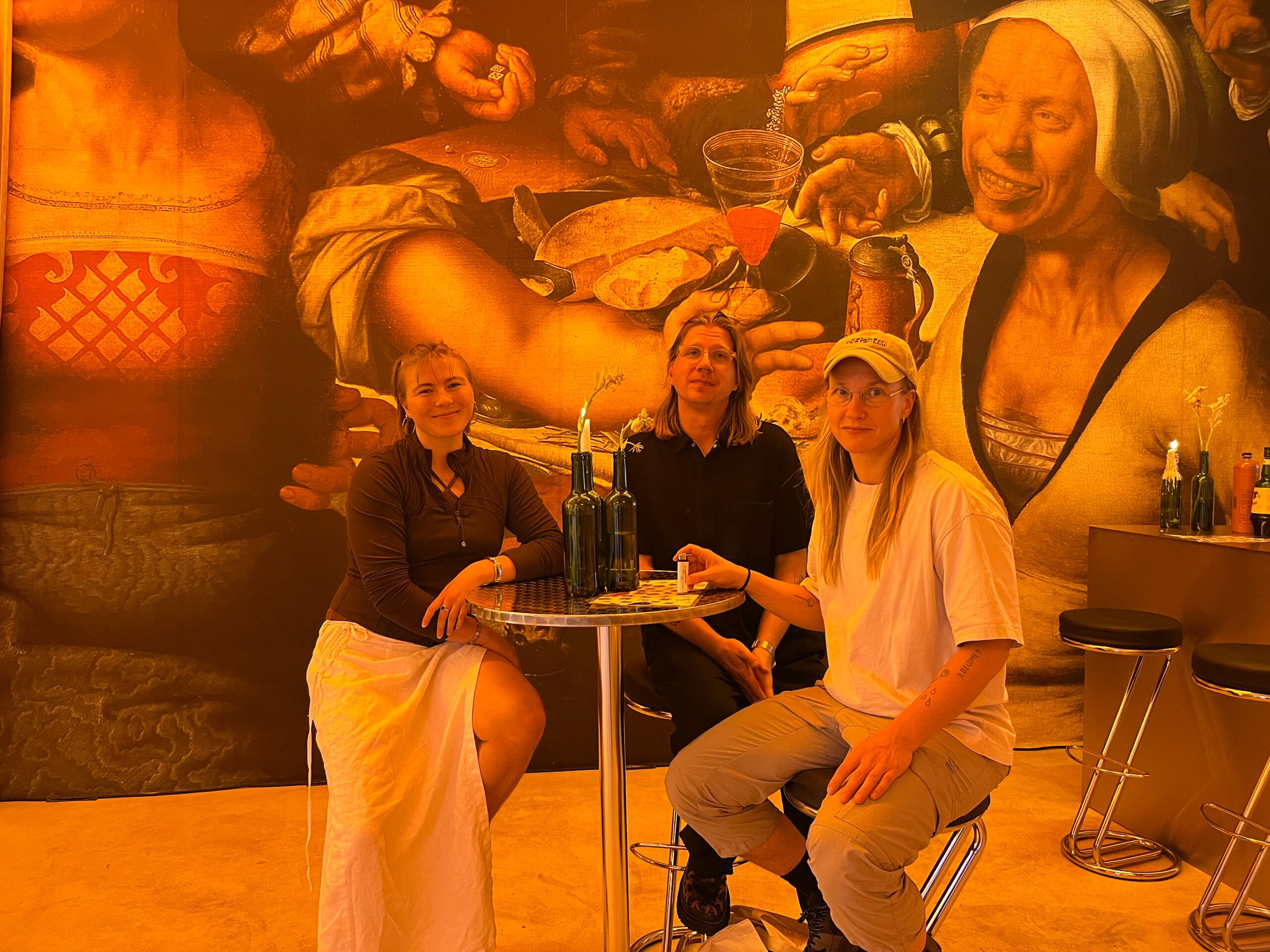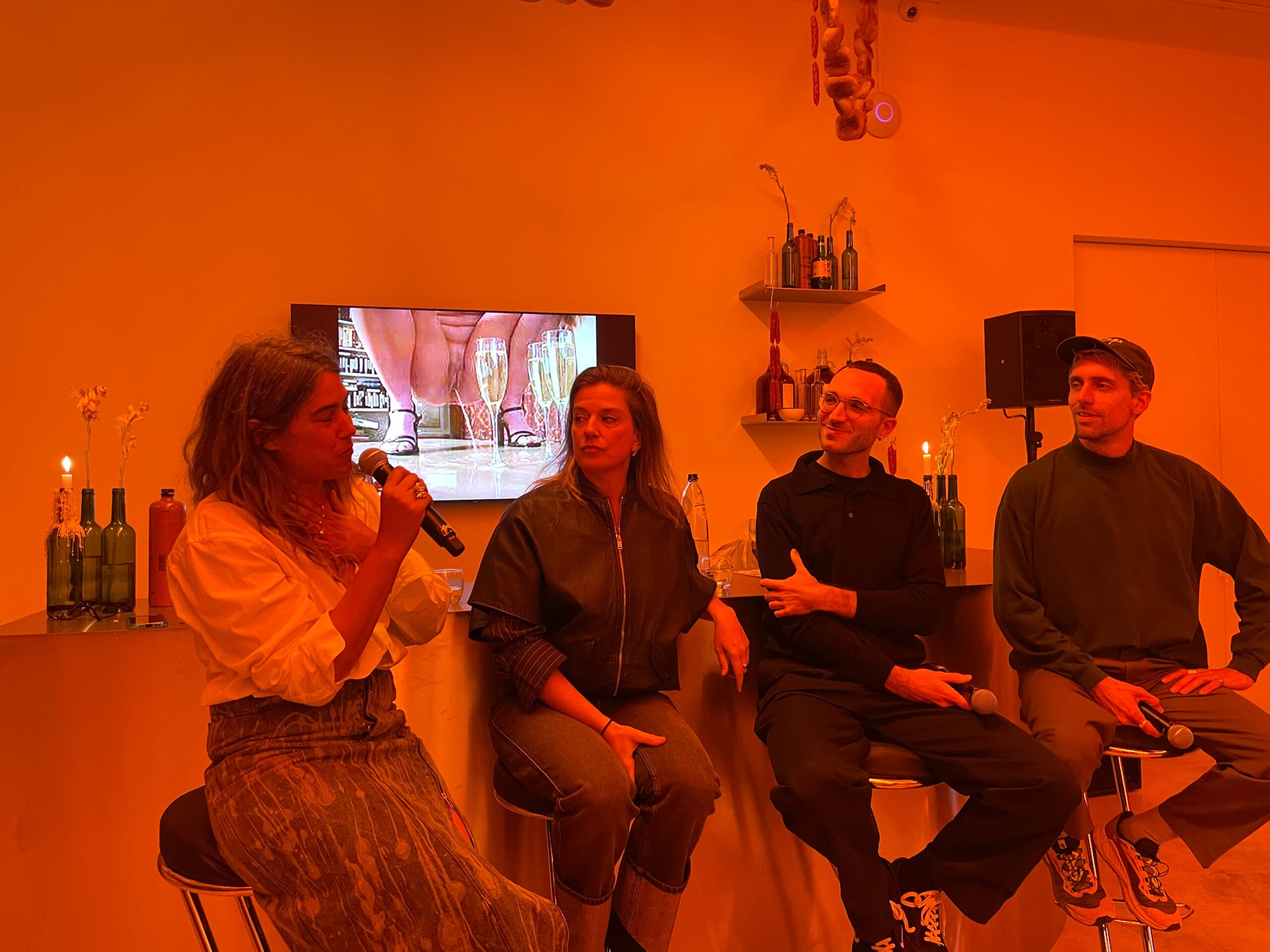In our latest blog post, Programme Assistant, Tilda Forss, shares their take after attending a RendezVous – Brussels Art Week talk with Miet Warlop, who’ll be representing Belgium at the 2026 Venice Biennale.
In an age of brain-rotting and doom scrolling, moments of immediate togetherness are incredibly valuable to the fabric of the arts and society at large.
How is performance art moving into museums? How can curators and institutions best utilise liveness? What layers does it add to an experience? These were the central questions up for discussion as artists and curators settled into their third day of Brussels Art Week at the RendezVous Salon (a space created by the contemporary artist Zoe Williams – note the fantastic twist on Manneken Pis pictured above). Read what Miet Warlop (Belgian Pavilion, Venice Biennale), Eliel Jones (KANAL-Centre Pompidou), and Paul Briottet (Bozar) had to say about the museum as a stage, with some post-event reflections from invited Finnish curators Max Hannus (Kiasma) and Sakari Tervo (Pitted Dates).
Performance in the museum: past and present
From the outset, the discussion made one thing clear: performance art is more important now than ever. In an age of brain-rotting and doom scrolling, moments of immediate togetherness are incredibly valuable to the fabric of the arts and society at large. Yet, as Eliel Jones noted, performance art today is rooted in a long history of artists negotiating their place within institutional spaces. Performance artists have always made their way into museums, whether they were accepted as official artists or not, a core tenet of institutional criticism employed by several hugely influential performance artists of the ‘70s and ‘80s, such as Adrian Piper and Andrea Fraser. Today, the art form has entered the mainstream, but Jones admitted that the topic of discussion remains fresh as the challenge of navigating live arts meaningfully and sustainably endures, especially in relation to large visual arts institutions.
The contemporary urgency of live art
Warlop argued that the theatrical elements of a performance can, and should, break with the decorum of a museum. Further, she noted that pursuing the inclusion of live performances in such spaces necessitates a shift away from old models, in which live arts often serve an accessorising function, used primarily to open or close an exhibition. Warlop wished instead to emphasise the possible staying-power of performance art in its own capacity.
“Live art performances force us to really see objects, events, and language, rather than gliding past them.”
The specific capability of live performances is that they create moments that are out of our routine, in spaces that are alive, outside of a theatre. As Viktor Shklovsky argued in his 1917 essay Art as Technique, the function of art is precisely that: to make the familiar strange through defamiliarisation. By disrupting our habitual perception, live art performances force us to really see objects, events, and language, rather than gliding past them in the automated way we experience everyday life. Live artists as such become mediators, forcing the voyeurs – passive audience members – to transform themselves into co-owners of a space and a situation. This sense of sharing an experience with others, connecting us to a sense of time and the language of an artist, is a distinct and affecting way to partake in a museum.
Curating liveness
« And isn’t it such a Western idea to split apart spaces according to the different mediums of art? » Paul Briottet mused. Shouldn’t there inherently be a compromise between how artists are artistically challenged to use a space and how a museum is challenged to let a space be used? Should artists and cultural professionals alike not share the responsibility of reinvention?
Eliel Jones’ position at Kanal-Centre Pompidou served as an answer to Briottet’s questions. Jones works as a curator specialised in performance and time-based media, a position that speaks to a growing institutionalisation of the form. Further, the idea of building space for performance art into the blueprints of institutions is also to be realized by Kanal-Centre Pompidou’s new renovation. Jones teased they would use the vast former car factory to let half the space remain as public “boulevards” and that they would use “soft infrastructure”, such as curtains or screens, to create separated rooms within rooms and delineated spaces. This goes to show that there’s a large interest in reimagining and expanding the technology and management of liveness in museums.
Attention to the moment
After the talk, as we walked to the next gallery event, I briefly interviewed Max Hannus (Kiasma) and Sakari Tervo (Pitted Dates). Both acknowledged that performance operates differently from the visual arts, and that it should not be forced into direct competition.
Instead, a quality of live performance events that Tervo wants to accentuate is their exclusivity. The power of performance art, according to Tervo, lies in the fact that you have to get off your couch and go see it. Anyone can go and take the same old picture of the same old painting in a museum, but not everyone will catch a performance. This singularity of experience renders the audience more interested and connected to the place, and each other.
“Performance art turns attention from the object to the moment.”
Similarly, for Hannus, the strongest potential of performance lies in its capacity to layer a space and add a sense of ‘meta-ness.’ Hannus demonstrated this with the example that people commonly go to the Louvre to take photos, not of the Mona Lisa, but of the people taking photos of the Mona Lisa. The photographers, the concept, the absurd event, is what is exciting – more so than even the art itself. In the same way, performance art turns attention from the object to the moment.
Ultimately, performance in museums challenges artists, audiences, and institutions to reconsider what it means to inhabit, witness, and participate in art.

From left to right: Tilda Forss, Sakari Tervo, and Max Hannus in the Salon de RendezVous. Photo by Oscar Arminen.
References:
Shklovsky, Viktor. « Art as technique. » Literary theory: An anthology 3 (1917): 8-14.
RendezVous – Brussels Art Week took place from 4–7 September 2025 with a city-wide programme celebrating Brussels’ contemporary art scene. This year, in collaboration with the Finnish Cultural Institute for the Benelux and Frame Contemporary Art Finland, RendezVous invited curators Sakari Tervo and Max Hannus to explore Brussels’ artistic landscape, cultivating new connections and inspiring creative exchange. Learn more about the curators.
Cover photo: RendezVous talk in the Salon de RendezVous (6.9.2025), moderated by Evelyn Simons, with Miet Warlop, Eliel Jones, and Paul Briottet. Photo by Tilda Forss.

